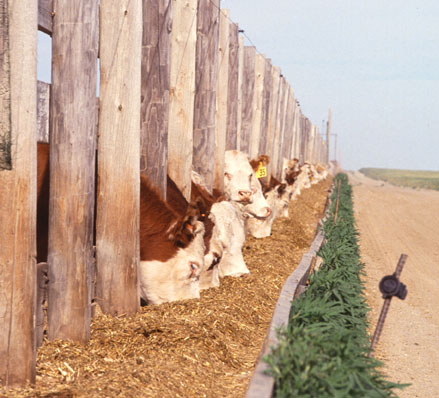Behavior Depends on Consequences
When someone asks you for help, do you prefer to be asked nicely and then rewarded with a "thank you" or "nice job?" Or do you prefer they scream to get you moving and then criticize you when you're finished? What ridiculous questions! We all prefer to be treated with respect. Yet, think how we often treat our animals, yelling, hot shots, etc. Using positive, gentle techniques in the long run is normally faster and easier on you and your animals.
Principle: Positive consequences increases the likelihood of an animal repeating a behavior and negative consequences decreases the likelihood of an animal repeating a behavior. Positive consequences have fewer negative side effects.
Example 1: Moving Animals through Chutes.
Negative Action: Yell, make a lot of noise and use a hot shot.
Result: Animal moves through shoot, eventually.
Side effects: 1) Animal kicks or jumps over the corral or alley way fence endangering the handler and itself. 2) Animals refuse to enter the corral or alley ways the next time they are worked. 3) They lose weight. 4) They suffer from increased stress and are more like to become sick.
Positive Action: Move animals quietly through chutes using low-stress livestock handling techniques.
Result: Animal moves through chute quickly, quietly and calmly.
Side Effects: Animals willing enter corral easily the next time they are worked.
Example 2: Getting Animals to Eat a High Energy Food.
 Positive: Introduce animals to foods they will be fed in the feedlot with their mothers in a familiar environment. Offer familiar foods in a new environment and animals eat it readily. Gradually increase food to allow animals' rumens to adjust to new food high in energy.
Positive: Introduce animals to foods they will be fed in the feedlot with their mothers in a familiar environment. Offer familiar foods in a new environment and animals eat it readily. Gradually increase food to allow animals' rumens to adjust to new food high in energy.
Result: Animals eat food and gain weight quickly.
Negative: Starve animals until they eat the new food. Offer them all the new food they can eat in a the new environment.
Result: Animals refuse to eat. After several days, they try the new food which results in positive consequences. They increase intake of the food quickly but suffer from acidosis because their rumen microbes have not had time to adjust. They decrease intake and slowly increase intake but never eat as well as the animals above. They gain weight more slowly and reach final finish weight several weeks behind the animals above.
Side effects: Animals gain weight slowly. Many get sick and have to be treated with antibiotics.

